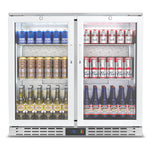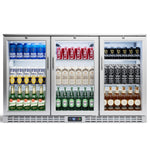You have no items in your shopping cart.
For commercial establishments like restaurants, hotels, and supermarkets that rely on a stable ice supply, critical operational equipment is ice makers. The choice of cooling method, air or water cooled, directly affects installation difficulty, operating costs, and operational stability, so important is this choice. Preventable are malfunctions and cost overruns with the right solution chosen. Below are some key considerations:
At the core of an ice maker’s working logic is the refrigerant’s circulation and heat absorption. Slower ice making, compressor overload, and even equipment burnout can result from inadequate heat dissipation. Using a fan to carry away heat from the condenser, with no need for additional water lines, is how air cooling works; Surrounding the condenser with water for cooling, which requires connecting to the water inlet and outlet systems, is how water cooling operates.
For small and medium-sized businesses, more user-friendly are air-cooled ice makers. Easy to install, they are simply plugged into a power source, with no need to modify the water system, making them suitable for rented spaces or confined areas. Water-saving and environmentally friendly, it is: it consumes water only for ice making, with no additional water needed for heat dissipation. This reduces water bills and prevents pipe blockages. Lower too are initial purchase costs; models of the same capacity are 15%-30% cheaper than water-cooled ones, making them ideal for small restaurants and convenience stores with limited budgets. Dependent on environmental conditions, however, it is: in high-temperature, poorly ventilated environments, ice-making efficiency may drop by 20%-30%. Additionally, the fan may draw in dust and grease, requiring weekly filter cleaning and monthly condenser blowing. Further, raising local temperatures heat dissipation can increase the air conditioning load.

For high-load, high-demand scenarios, more suitable are water-cooled ice makers. Unaffected by ambient temperature, they are even in 40℃ outdoor environments or busy kitchens, and the drop in ice production is kept within 5%, ensuring a continuous ice supply. Only 30-40 decibels is their operating noise, making them ideal for high-end hotels, hospitals, and other scenarios requiring quiet operation. In the long run, more electricity costs does it save the high efficiency of water flow heat dissipation, meaning that a 1000-pound daily output model saves over 8,000 yuan annually in electricity costs compared to air-cooled versions. A higher barrier to entry, however, it has: it uses 5-8 times more water than air-cooled systems, increasing monthly water bills by 80-110 yuan, and even risks fines in some water-scarce areas. Required for installation is modification of the water system costing 2,000-5,000 yuan, and older sites may not be suitable for such construction. In some environmentally strict areas, a water circulation system or water use permit is needed, creating compliance risks.

When choosing, precise matching of the scenario is crucial: For small to medium-sized catering establishments (daily usage 200-500 lbs), air-cooled systems are preferred, with installation away from heat sources, sufficient ventilation space, and regular cleaning; for large scenarios (daily usage 500-2000 lbs), water-cooled systems can be chosen, with a water circulation system to save water, and regulations should be confirmed and the water system inspected in advance; for quiet or high-temperature scenarios without air conditioning, water-cooled systems are mandatory, while air-cooled systems are preferred in environmentally sensitive areas.
Featured in Coolake's commercial ice makers feature an air-cooling system and a powerful compressor, effectively increasing the ice production rate and saving energy, which offers significant benefits across various sectors, including food service, healthcare, and office settings. In food service, its high ice production capacity and consistent performance ensure a steady supply for beverage service. In healthcare, its sanitary features and reliable operation support patient care needs. Office environments benefit from their convenient, self-contained design and ease of use. Regardless of the model, regular maintenance is key and can extend the lifespan by 3-5 years.

No absolute superiority exists between air-cooled and water-cooled systems: what matters is scenario suitability. To ensure the ice machine operates reliably, a comprehensive assessment is required by operators: they need to evaluate the environment, ice consumption, and site conditions, calculate the total cost, and then pair this with scientific maintenance. Necessary for reliable operation is scientific maintenance to be paired with the aforementioned assessments and calculations.
 English
English







